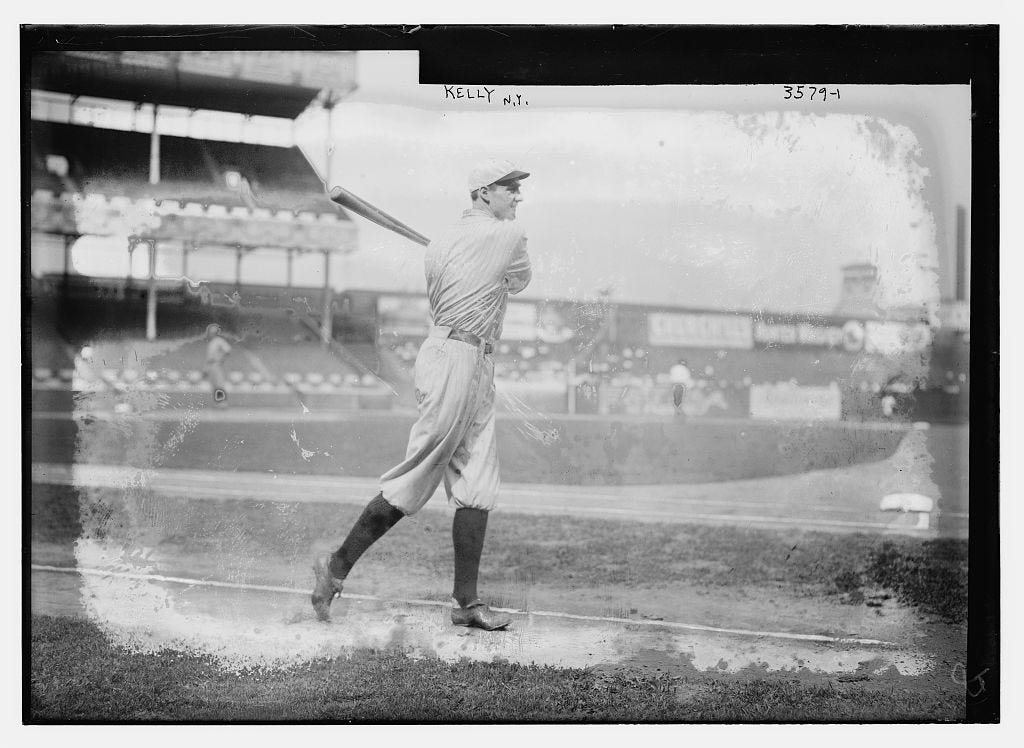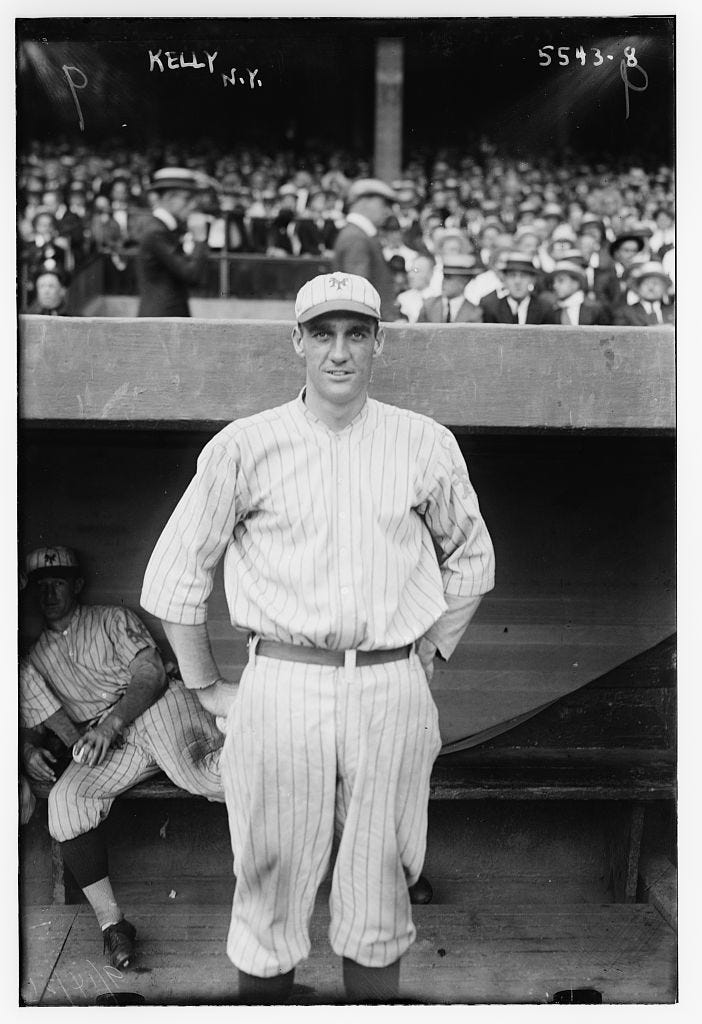
When Wilmer Flores became just the third Giants player in 125 years with three homers and eight RBI in a home game and they flashed the above graphic, there was a lot of “Who the hell is High Pockets Kelly and how did he get that name?” from the audience. Well, that’s why I’m here.
George Kelly was born in San Francisco in 1895 and grew to be a 6 feet 4 inches, which was incredibly tall for a baseball player in the early 1900’s. Most players were about six feet tall or less. The taller guys were all outliers. Babe Ruth was 6’2”, while Ty Cobb and Christy Mathewson were 6’1” and even the great Lou Gehrig barely made it to six feet, while Kelly’s manager John McGraw was 5’7”, so you get the idea.
But George was not only taller than your average player, but he was also incredibly skinny as a young man. He was probably nicknamed “Beanpole” or some early 20th-century equivalent at some point. For some reason no biography I have seen of him has a documented way he got nicknamed “High Pockets.” I like to think that one day at the ballpark he was standing far enough away from someone facing the other direction when they forgot his name, and seeing that his pants were so much higher than everybody else’s just yelled, “Hey, High Pockets!” and everyone heard it, laughed, and it stuck. If George’s reaction wasn’t the greatest, well, that just made it stick more…
Baseball nicknames used to be clever. Anybody who wore glasses was called “Professor.” Left-handers were immediately “Lefty.” George Herman Ruth was called “Babe” because he was such a prodigy and looked young. Where they were from was always a possibility. A rookie for the Brooklyn Dodgers in the 1910’s was playing cards and asked where he was from and he said, “Kansas City,” and they started calling him “K.C.”, which became “Casey,” and he was known as Casey Stengel the rest of his days. If you said a certain phrase to everyone you met, you might be called “The Say Hey Kid.” And so on. Now you’re A-Rod. Real original, guys.

Kelly made the major leagues with the New York Giants as a gangly 19-year-old in 1915 and was just awful, but McGraw insisted he would be good. He finally found his way in 1920 and terrorized pitchers for a decade, helping the Giants to four straight pennants and two World Series championships. McGraw called him “the best clutch hitter I’ve ever seen,” and he saw everybody in the first decades of the 20th century. Kelly was elected to the Hall of Fame in 1973 by the veterans committee (which at the time consisted of a ton of former Giants from the 20’s and 30’s, therefore they elected all their teammates, which is why the Giants have more Hall of Famers than anybody else).
The election was controversial at the time because while Kelly was in the majors for 16 years, he was really only above average for ten of them. His four partial years before 1920 were just abysmal, and the last two weren’t so great either. The thing is, in those good ten years he was one of the best hitters in the league, and he changed the way first base was played forever by becoming a true fielder on relays and other plays when there wasn’t a runner on, as previous first basemen had stayed close to the bag on every play. The last out of the 1921 World Series happened because the runner didn’t think the ball would get through, Kelly rifled a throw to third and the man was tagged out. And besides, there are enough iffy guys in the Hall of Fame now that shall remain nameless (*cough* Scott Rolen *cough*) that Kelly looks absolutely worthy.
However bad he was at the time, Kelly was also the only Hall of Famer that played for the 1916 Giants when they won a still-MLB record 26 games in a row, which I wrote a book about, which you should get.
As for the current club, the other day Giants teevee guy Mike Krukow was talking about the new rules for pitchers in the pitch clock era, and he got stuck on the word “disengagement,” which used to just be called “stepping off the mound.” Krukow said, “I never heard of the word ‘disengagement’ in baseball until about two years ago. To me a ‘disengagement’ was when you got the ring back!”
The horse that won the Kentucky Derby, “Sovereignty,” intentionally skipped the Preakness this past weekend but might race in the Belmont in a couple weeks. Yes, there are many things wrong with horse racing like the treatment of the steeds and the jockeys (which seems to not be going away), but like golf the big events are still fun to watch. Several years ago I came up with the concept that all stables that enter a horse in the Derby must sign a guarantee that if they win the Derby they will race in the Preakness, and if they then win the Preakness must also run the Belmont so that people are actually interested in the Triple Crown pursuit…
Well, a number of proper horse racing folks are actually proposing a better idea to make it happen without a guarantee, which is lengthening the time between the Triple Crown races. Gone are the days of “Seabiscuit” getting saddled up every two to three weeks for the five-month racing season. “Seabiscuit” ran 15 races in 1937 alone (and won 11), while “Sovereignty” has only run six… total…
So, the best idea is to space out the races. One a month for three months (or thereabouts), with the final leg perhaps even running on the 4th of July. The horse racing traditionalists are against this, of course, but they also are ignoring the part where they aren’t drawing ‘em in like they used to. Most people- if they’re not at a casino or track or OTB (Off-Track Betting parlor)- are interested in Triple Crown races and Triple Crown races only. At one point horse racing and boxing were more popular than pro football (this was a fact up until the TV era really took hold in the late ‘50’s), and now both sports only get most people interested in it a few times a year.
Speaking of sports that used to be huge deals that now have fallen way back on the general interest scale (though the race itself still gets 3000,000-plus attendees, an extraordinary number), there are some rather troubling problems for Indianapolis 500 this upcoming weekend. What kind of problems? Oh, just the two-time defending champion being made to start in the back row after his team modified a part to make it more aerodynamic that you’re not allowed to make more aerodynamic. So two-time defending champ Josef Newgarden and teammate Will Power will start from the back row, instead of the top third, where they had qualified to start from with the illegally-modified part.
Newgarden and Power drive for Team Penske, owned by legendary IndyCar racer Roger Penske. Why is this potentially a much bigger problem? Well, Roger Penske also happens to own the Indianapolis Speedway and the IndyCar Series itself. Does he say the right things about not showing any favoritism? Sure. But what’s he supposed to say?
But really, nobody really seems to be interested in severe conflicts of interest nowadays anyway.
The thing that might save the 500 this year is that a rookie driver won pole position and drives for a team that is racing in it’s first-ever 500, something that hardly ever happens- and never at the same time.
The kid’s name is Robert Shwartzman, a 25-year-old Russian-Israeli driver for an Italian-based team called PREMA, which has done Formula One and endurance racing stuff for more than 40 years but has just now begun entering IndyCar stuff.
Only four true rookies have started from pole position in the Indy 500 since it began in 1911 (because everybody was technically a rookie for the first one). The first time it happened was for the 1914 race.
And since you can’t make this stuff up, guess who started playing pro baseball in 1914 for the first time as a 19-year-old with the minor-league Victoria Bees of the Northwestern League?
Let’s just say Robert Shwartzman, at barely six feet tall, will never be given the nickname “High Pockets.”





Beautiful, full circle of an article.
Nicknames do lack creativity today.
Kung Fu Panda
Oil Can Boyd
The Bird
The Human Rain Delay
Three Finger Brown
The Splendid Splinter
The Iron Horse
Sigh...
I think any baseball player who admitted to reading a book in the fifties was called "perfessor."